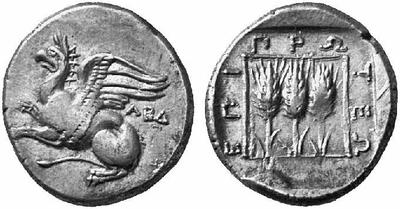AC 107 - Abdera, silver, tetrobols (411/10-386/5 BCE)
From SILVER
410 BCE - 385 BCE Silver 2,242 kg
Description
| ObverseInscription or printing placed on the obverse.: | ABΔ (Greek).Griffin springing left, rising on his hind legs. |
| ReverseInscription or printing placed on the reverse.: | EPI - PPW - TEW (Greek).Three spikes side by side in line square, the whole in recessed square, legend on the perimeter. |
Mint and issuing power
| MintIdentifies the place of manufacture or issue of a numismatic object.: | Abdera | Ancient regionAncient region.: | Thrace | Modern countryModern country: Greece | AuthorityIdentifies the issuing power. The authority can be "pretended" when the name or the portrait of X is on the coin but he/she was not the issuing power. It can also be "uncertain" when there is no mention of X on the coin but he/she was the issuing power according to the historical sources: |
Chronology
| FromIdentifies the initial date in a range assigned in a numismatic context. | 410 BCE | toIdentifies the final date in a range assigned in a numismatic context.. | 385 BCE | PeriodTime period of the numismatic object.: Classical 480-323 BC |
Physical description
| MetalThe physical material (usually metal) from which an object is made.: | Silver |
Median weightMedian of the weights of numismatic objects (in grams). in grams | 2.85 | DenominationTerm indicating the value of a numismatic object. Examples: tetradrachm, chalkous, denarius.: | tetrobol |
StandardStandard.: |
Image

AC107 Abdera.jpeg [1]
References
| Die study referencePublication of the study: | May 19661May 1966 | ||
| Coin series referenceReference to coin series study: | RQEMAC2RQEMAC, n° 107 | ||
Obverse dies distribution
| FrequencyFrequency of specimen in distribution. ᵖ | Number of obversesNumber of obverse dies. ᵖ (o) | % (o) | Number of coinsNumber of coins. (n) | % (n) | Die nameName(s) of the die(s). |
| 1 | 8 | 24.24 | 8 | 6.61 | 208, 234, 258, 259, 260, 264, 265, 268 |
| 2 | 2 | 6.06 | 4 | 3.31 | 262, 266 |
| 3 | 11 | 33.33 | 33 | 27.27 | 232, 238, 239, 240, 242, 255, 256, 263, 267, 271, 272 |
| 4 | 5 | 15.15 | 20 | 16.53 | 209, 257, 261, 270, 274 |
| 5 | 3 | 9.09 | 15 | 12.4 | 233, 236, 237 |
| 6 | 1 | 3.03 | 6 | 4.96 | 241 |
| 8 | 1 | 3.03 | 8 | 6.61 | 207 |
| 9 | 1 | 3.03 | 9 | 7.44 | 273 |
| 18 | 1 | 3.03 | 18 | 14.88 | 219 |
| Total | 33 of 33 | 99.99 | 121 of 121 | 100.01 |
Reverse dies distribution
no distribution is available
Quantification
| Number of obversesNumber of obverse dies. ᵖ (o) | 33 | Number of singletons (o1)The number of singleton coins. ᵖ | 8 |
| Number of reverse diesNumber of reverse dies. (r) | NC"NC" is not a number. | Number of coinsNumber of coins. (n) | 121 |
| Coins per obverse dieNumber of coins per obverse die. (n/o) | 3.67 | Coins per reverse dieNumber of coins per reverse die. (n/r) | |
| Reverse per obverse ratioRatio of obverse dies divided by reverse dies. (r/o) | Percentage of singletons (o1)number of coins (n) divided by the number of singletons (o1) ᵖ | 24.24 % | |
| Original number of dies (O) (Carter 1983 formula)The estimation of the number of coins according to Carter 1983 ᵖ | 39.33 | Coins struck if 20,000 as average productivity per dieCoins made if the average productivity for obverses (according to Carter) is 20,000. ᵖ | 786,600 |
| Original number of dies (O) (Esty 2011 formula)The estimation of the number of coins according to the singleton formula in Esty 2011 ᵖ (O) | 45.38 | Survival rate if 20,000 as average productivity per dieSurvival rate if average productivity is 20,000. ᵖ | 0.00015 |
| Coverage (o = % of O) (Esty 1984 formula)Esty 1984 - coverage (% of O) ᵖ (o = % of O) | 93.39% | Die productivity if survival rate 1/2,000Average productivity if survival rate is 1/2,000. ᵖ | 6,153.06 |
| Weight of silver (in kg) if 20,000 coins per die (O = Carter formula)Carter 1983 * Median weight * 20000 (*10 if gold or electrum) ᵖ | 2,242 kg <br /> 2,242 kg | Die productivity if survival rate 1/5,000Average productivity if survival rate is 1/5,000. ᵖ | 15,382.66 |
Remarks